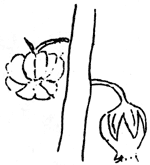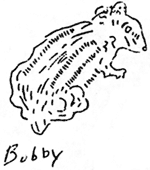Ghost Plants
By Lincoln Constance, Ranger-Naturalist
In the deep forests of Crater Lake there grow a number of oddly-colored, leafless plants, which look like phantoms in the shadows. Their secretiveness betrays that they are bent upon no honest business, and they are, indeed, the robbers of the plant kingdom. Possessing no leaves of their own with which to manufacture food, they prey upon their more industrious neighbors, or live ghoulishly upon the decaying vegetation.
Most of the leafless plants are members of the Heath Family, which includes such common plants as the Manzanitas, the Heathers, the Rhododendrons, and the Madrone, beside their degenerate kin. The “Stick-candy” (Allotropa virgata) is very noticeable by virtue of its red and white stripped stem, bearing a dense spike of flowers of the same colors. It looks like nothing in the world so much as a barber pole, whose gaudy lines have been straightened out, and set vertically.
A close but less gaudy relative of the stick-candy is the “Pine Drops” (Pterospora andromedea). Again we find an erect plant, surmounted by a dense spike of flowers, but this plant varies from tawny to red, and is completely covered with short sticky hairs. The flowers are myriads of little silent bells, which might have been grafted on from some Manzanita or Heather. While the Stick-candy seldom reaches more than a foot in height, the Pine Drops may ascend as much as three or four feet.
The “Pine Sap” is a smooth, fleshy little plant, colored red, yellow or orange, an bearing a raceme of beautiful, waxy flowers of the same hue. It is only two or three inches high, but its brilliant yellow or red tones render it quite conspicuous when one does chance upon it. The Pine Sap is closely related to the “Indian Pipe”, which bears a number of pure white, one-flowered shoots in dense clusters, and is quite common elsewhere in the state, but is apparently not found in the Park.
That most aristocratic family of flowers, the Orchid Family, also contributes two of its black-sheep to this eerie group. These are the “Coral-roots”, which are probably the most common and conspicuous members of this band. The “Merten’s Coral-root” (Corallorhiza mertensiana) is a rich brownish-purple spire, studded with flowers or the typical Orchid form. The “Spotted Coral-root” (Corallorhiza maculata) is usually lighter in color, affecting a yellowish brown, and its flowers each bear a white lip, spattered with irregular purple blotches. These orchids live upon decaying humus, and to utilize it most effectively, they have developed a much-branched system of fleshy roots, simulating a heap of interwoven grey coral.
Growing among the Stone-crops, or sedums, in the crevices of the rocks, little tubular, violet-tinged flowers may sometimes be discovered. The stalks are yellowish, and a few shriveled bracts are all the remain of the green leaves that may have adorned and nourished them before they strayed from the unattractive path of independence. This is the “One-flowered Broom-rape” (Thalesia uniflora), which is an out-and-out parasite, and must derive all its nourishment at the expense of its more self-reliant neighbors.
Since most of these plants have relatives who can, and do, manufacture their own food, it is probable that these phantom flowers also once lived entirely by their own industry. But the competition for light and air was too keen in the deep arboreal shade, so they resorted to trickery. Their wiles proved effective, and they throve, but the stump of the flabby parasite is upon them, and they have lost forever the ability to produce green leaves and live self-reliantly.
Bobby Learns to Trust Nobody
Bobby, our little golden mantled squirrel, which has made her house under the so-called Information Bureau, the building now used as the Educational Headquarters, had a very harrowing experience some three weeks ago. She had come to trust the rangers and our park visitors, and it was with a misguided sense of safety, that she would flit with a deft hop, skip and jump to take the niceties offered and fill to capacity the pouches in the sides of her face. She would carry these supplies for the coming winter to her home under the floor of the building.
About three weeks ago in a trusting and good-natured manner she was attracted by some of our park visitors who evidently had not read the park regulations concerning the capture and removal of the wild life. The capturers enticed Bobby into a paper bag containing salted peanuts and then quickly placed the bag in a tin bucket. The lid on the bucket had been punctured to permit air to enter the prison. It is quite evident that the intended capture of a squirrel or chipmunk had been deliberately planned.
One of the Oregon University football players who is employed at the park this summer and is incidentally securing a swarthy coat of tan and developing bulging muscles for the coming football season, seeing the impending catastrophe, hurriedly rushed into the Naturalist’s office and exclaimed: “Someone is attempting to steal Bobby, they have her in a car and are just ready to drive off!” The Park Naturalist immediately went to Bobby’s rescue, suggesting that such action just was not done and that other visitors would come from day to day who would also enjoy the frugal activity and antics of the golden mantle squirrel along the rim and that Bobby must be released. The admonition was given with that playful smile which saves a deal of hard luck and the would be captors of Bobby, the tailless one, somewhat reluctantly to be sure, released our pet and now there is another tail about Bobby.
For several days after this unfortunate episode Bobby was not seen. She probably remained at home and recovered from her nerve-wracking experience, but gradually she regained her and now can again be seen scampering merrily around the rim wall and taking bits of food offered her.
Last year the readers of Nature Notes will recall how we considered changing her name from Bobby to Roberta when she brought out, from the security of her basement home, five beautiful little squirrels for our consternation and approval.
So Bobby is now a privileged squirrel; her faith in humans is being gradually restored and again we find her in and about the Information Bureau. The Naturalists of the Educational Staff have vowed that in case some misguided visitor again attempts to capture any one of our animals inhabitating the park, the culprit will be thrown into the blue depths of Crater Lake hoping that the offenders will be devoured by some of the legendary Indian Gods.




